

How to Grow Berries. Of all of the things that I grow in my garden, berries are definitely on the top of the list as a favorite.
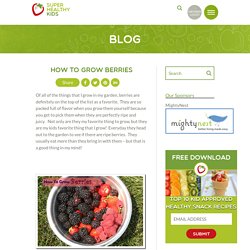
They are so packed full of flavor when you grow them yourself because you get to pick them when they are perfectly ripe and juicy. Not only are they my favorite thing to grow, but they are my kids favorite thing that I grow! Everyday they head out to the garden to see if there are ripe berries. They usually eat more than they bring in with them – but that is a good thing in my mind! Pin It By following a few gardening practices, your berry plants can produce an abundance of nature’s most delectable food. Grow your own sweet potatoes - Outlaw Garden. Welcome, sweet potato fans!
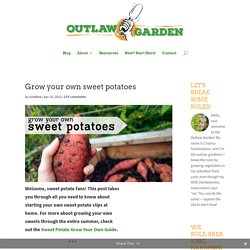
This post takes you through all you need to know about starting your own sweet potato slips at home. For more about growing your own sweets through the entire summer, check out the Sweet Potato Grow Your Own Guide. Have I told you yet about my love affair with sweet potatoes? Have I explained how they are the ideal plant for a front yard vegetable garden; the perfect combination of beauty and ease and taste? Have I mentioned their attractive foliage and their purple flowers? Oh. Ok, then. Here, in northern Virginia (USDA Zone 7a), we can plant our regular potatoes in March. If we don’t plant the sweets until June, why am I writing about them in April? Note: You can skip this whole thing, and just order sweet potato slips from a quality nursery or seed company. To make new sweet potatoes, we start with an old sweet potato.
Don’t think organic makes a difference here? Ok. Next, place each section of sweet potato into a container with water. Practical Gardening: Easy Homemade Fish Emulsion Fertilizer. I've read with much interest from the internet how folks prepare homemade fish emulsion and swear by its effectiveness.
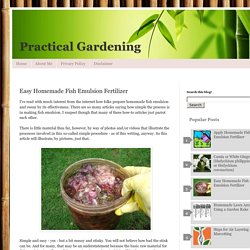
There are so many articles saying how simple the process is in making fish emulsion. How We Plant a Tomato. Love Apple Farm's tomato plant sale will be held at 5311 Scotts Valley Drive in Scotts Valley (near Santa Cruz, CA) and will begin on Saturday, March 28, 2015 and continue EACH day until the end of May.
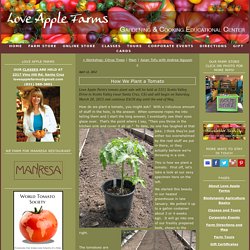
Seed Starting - How To Start Seeds. 2.
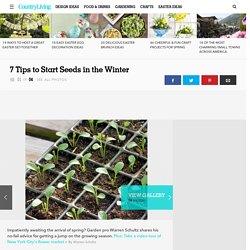
Study the seed packet. Consider that little envelope your manual. It'll tell you when to start seeds inside—typically, four to eight weeks before final frost (consult almanac.com to check the date for your area). Later, once you're ready to move the plants outside, the packet will provide info on sun requirements, spacing, and more. Note: Pay attention to the expiration date; old seeds are less likely to germinate. Evaluating Soil Texture. Soil texture—the relative proportion of sand, silt, and clay particles—is one factor in soil’s ability to provide a healthy environment for roots.

Soils that contain more than 40 percent clay, the smallest mineral particles, are easily compacted and often lack pore spaces. Here’s a simple way to gauge the texture of garden soil. Dig a representative sample from the top 8 inches of soil. You might wish to dig soil from several spots in your garden and mix them in a bucket. Remove stones, roots, mulch, and other chunks of organic matter. Put about 2 inches of soil in a straight-sided, flat-bottomed quart jar.
Place the jar in a spot where it can remain undisturbed for several days. Use a ruler to measure the depth of sand, silt, and clay, as well as the total soil depth in the jar. For example, the jar above shows 1/2 (0.5) inch of sand, 5/8 (0.625) inch of silt, and 3/8 (0.375) inch of clay, for a total of 11/2 (1.5) inches. Alternative Gardning: How to Plant and Harvest Garlic. Taking lavender cuttings - Amateur Gardening. Emilie Griffin gets her lavender bushes in shape for a good show next year Lavender cuttings are easy-peasy!
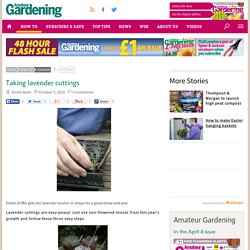
Just use non-flowered shoots from this year’s growth and follow these three easy steps. Planting Your Spring Vegetable Garden - A Healthy Life For Me. Learn When you should be Planting Your Spring Vegetable Garden.
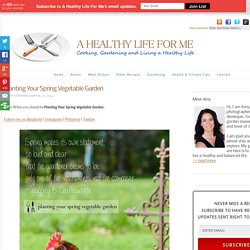
Follow me on Bloglovin | Instagram | Pinterest | Twitter Spring makes its own statement, so loud and clear that the gardener seems to be only one of the instruments, not the composer. ~Geoffrey B. Charlesworth This quote says it all and It’s About Blooming Time spring showed up. We are all anxious to get out their and enjoy spring, the sunshine, blue skies warmer temperatures and the sheer beauty that spring brings. Once you pick your perfect piece of land to call your garden you need to make sure your soil is dry and warm enough, you want the soil temperature to be at least 60°F for most vegetables. Grow Your Own Food In The City {Watch Video}
Planting Your Spring Vegetable Garden - A Healthy Life For Me.